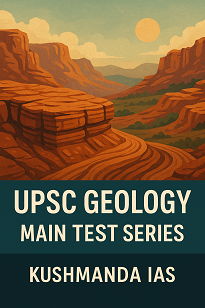UPSC GEOLOGY Subject Test Series for CSE 2025
UPSC GEOLOGY Subject Test Series for CSE 2025
A high-scoring answer in UPSC Geology follows a structured format comprising:
-
Introduction: Define or contextualize the concept.
-
Body: Use diagrams, classifications, and examples. Break down the concept scientifically.
-
Conclusion: Provide implications, applications, or recent developments if any.
UPSC values clarity, scientific accuracy, brevity, and proper integration of diagrams. A scattered or unstructured answer, no matter how accurate, often gets low marks. Following a clear format helps the evaluator navigate your thought process.
Salient Features:
- 10 Full Length tests. (English&Hindi)
- Evaluators assess on parameters like relevance, structure, depth of analysis, subheading use, keyword usage, multidimensionality, innovation (diagrams, flowcharts), conclusion quality, and time-bound completeness.
- UPSC answers are not essays; they must reflect a balanced viewpoint within word/time limits. Evaluation frameworks ensure candidates develop exam-centric writing that satisfies UPSC’s demand for clarity, content, and conciseness.
- UPSC checks quality under pressure. Evaluation creates a feedback loop where every mistake becomes a lesson. The constant loop of Write → Get Feedback → Rectify → Write Again improves articulation, speed, and scoring capability.
- Focus on key metrics to ensure 300+ Marks .
- High-quality Question as per the latest pattern of UPSC.
- Robust feedback mechanism through copy evaluation in a time bound manner.
- Model Answers of all tests
- Flexible schedule, write anytime after scheduled date.
- Fee: Rs 11000/- (Per Test Rs 1100/-)
Call: 860770992 (Discounts for EconomicallyWeaker Sections for all categories)
Examples:
Q. Compare and contrast the formation and tectonic significance of ophiolites and granulite facies terrains. What insights do they offer about the evolution of Precambrian crust?
Comparison of Ophiolites and Granulite Facies Terrains: Formation, Tectonic Significance, and Precambrian Crustal Evolution :
Ophiolites and granulite facies terrains are two contrasting geological units that offer profound insights into the tectonic processes and the evolution of the Earth’s crust, particularly during the Precambrian era. Though both are critical for reconstructing early geodynamic regimes, they represent different crustal levels, thermal regimes, and tectonic settings.
Formation Processes
Ophiolites are slices of oceanic lithosphere emplaced onto continental margins during subduction-related processes. They typically consist of a stratigraphic sequence from ultramafic rocks (peridotites), layered gabbros, sheeted dike complexes, to pillow basalts, and deep-sea sediments. They form at mid-ocean ridges, supra-subduction zones, or back-arc basins and are later obducted during continent-continent or arc-continent collisions.
Granulite facies terrains, in contrast, form deep within the continental crust under high-temperature (700–900°C) and moderate- to high-pressure (6–12 kbar) conditions. These terrains are primarily composed of felsic to mafic rocks (e.g., charnockites, enderbites) that have undergone high-grade metamorphism, typically during crustal thickening or tectonic underplating in collisional orogenic settings.
Tectonic Significance
Ophiolites are key markers of ancient oceanic crust and plate tectonic processes. Their presence in Precambrian terranes, such as those in the Dharwar Craton or the Eastern Desert of Egypt, suggests that oceanic lithosphere generation and subduction-like processes were operative even in the Archean to Proterozoic. Their emplacement records major suturing events during orogenies and helps delineate ancient plate boundaries.
Granulite terrains, on the other hand, reflect the dynamics of crustal reworking, thickening, and differentiation during orogeny. Their formation is often linked to continent-continent collisions, magmatic underplating, or mantle upwelling. The exhumation of granulite terrains indicates significant crustal stabilization and thermal evolution, key features of cratonization processes.
Insights into Precambrian Crustal Evolution
-
Plate Tectonics in the Precambrian: The existence of ophiolitic remnants in Precambrian shields supports the operation of some form of plate tectonics during early Earth history, albeit possibly different from modern-style tectonics in scale and dynamics.
-
Crustal Differentiation and Stabilization: Granulite terrains offer a window into the deep crustal processes that led to the stabilization of protocontinents. Their thermal and metamorphic histories suggest a hotter mantle and thicker crust during the Archean, possibly indicating vertical tectonics or plume-assisted crust formation.
-
Crust-Mantle Interactions: Both ophiolites and granulites show strong evidence of crust-mantle interaction. Ophiolites represent direct samples of the upper mantle and oceanic crust, while granulites reflect deep crustal melting and recycling processes, essential for understanding the chemical differentiation of the Earth.
-
Tectonothermal Regimes: The juxtaposition of ophiolites with granulite facies rocks in some Precambrian orogens (e.g., Southern Granulite Terrain, India) highlights complex tectonothermal regimes involving both horizontal (plate-driven) and vertical (plume-related or crustal overturn) processes.
Conclusion
While ophiolites document the existence and nature of oceanic lithosphere and subduction in the Precambrian, granulite facies terrains record the processes of crustal thickening, heating, and stabilization. Together, they provide complementary insights into the geodynamic mechanisms that built and stabilized the early continental crust, supporting a hybrid tectonic model for the evolution of the Precambrian Earth.
EVALUATION:
Strengths of the Answer:
-
Clear Structure and Organization
The answer is well-structured into logical sections—Formation, Tectonic Significance, Insights into Precambrian Evolution, and Conclusion. This improves readability and clarity. -
Accurate Geological Content
-
Ophiolite sequences are correctly described, including their stratigraphy (peridotite → gabbro → sheeted dikes → pillow basalts → sediments).
-
Granulite facies conditions (700–900°C, 6–12 kbar) and rock types (charnockites, enderbites) are accurately presented.
-
-
Balanced Comparison
The contrasts between ophiolites (oceanic crustal fragments) and granulites (deep continental crust) are highlighted effectively, particularly in terms of depth, pressure-temperature conditions, and tectonic setting. -
Tectonic Interpretation is Sound
-
The answer appropriately links ophiolites to ancient subduction and oceanic lithosphere.
-
Granulites are accurately tied to deep crustal reworking and continent-continent collision.
-
-
Integration with Precambrian Context
The answer offers a thoughtful reflection on how both terranes inform debates on early tectonic styles (e.g., whether modern plate tectonics existed in the Archean) and the stabilization of cratons.
Areas for Improvement
-
Need for Deeper Examples from Precambrian Terrains
-
The answer could have mentioned specific Precambrian ophiolite examples, like the Dongwanzi ophiolite (China) or Nuggihalli belt (India), and granulite terranes like the Southern Indian Granulite Terrain.
-
Naming more specific cratonic blocks (e.g., Dharwar, Tanzania Craton) would enhance credibility.
-
-
Limited Discussion on Metamorphic Overprinting
-
Precambrian ophiolites are often metamorphosed; this complexity is omitted.
-
Granulite terrains frequently show retrogression (e.g., to amphibolite facies), which can inform cooling and exhumation histories—this is underexplored.
-
-
No Mention of Geochronology
-
Insights from U-Pb zircon dating or Sm-Nd isotopic systems that help constrain the timing of crustal processes could enrich the evaluation of Precambrian crustal evolution.
-
-
Terminology Refinement
-
Phrases like “vertical tectonics” and “plume-related crust formation” are accurate but deserve clearer contrast with modern-style plate tectonics to avoid ambiguity.
-
Evaluation Score: 8.5/10
Why:
The answer demonstrates a strong grasp of geological concepts and effectively compares and contrasts ophiolites and granulite facies terrains. It offers a coherent synthesis related to the Precambrian, with insightful generalizations. However, it could be elevated further by integrating more case studies, emphasizing metamorphic complexity, and using isotopic/geochronological insights to anchor the tectonic interpretations.
Suggested Improvements in One Sentence:
Enhance the answer by incorporating specific case studies, acknowledging metamorphic overprinting and retrogression in ancient terrains, and referencing geochronological techniques that help resolve Precambrian tectonic events.
KUSHMANDA IAS HCS ACADEMY302, TDI TOWN CENTRE, PANIPAT, 1321038607570992
















